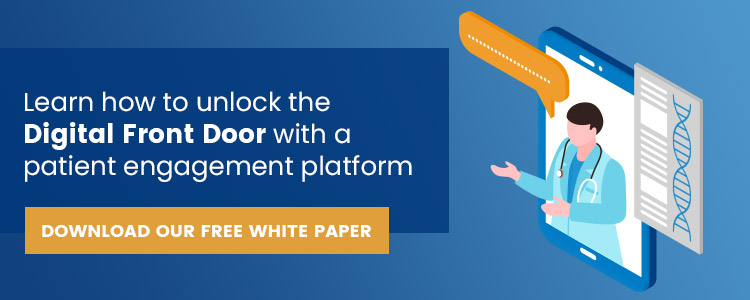What is a Patient Engagement Platform?
- Imogen Goodman
- April 23, 2021

In an era of relentless digital innovation, there are numerous new terms and technological concepts on a daily basis that don’t always have such a clear definition including buzzwords such as “digital front door” or “consumer engagement” or “patient engagement.” As anyone in today’s healthcare industry knows, patient engagement is an incredibly important concept, but the term is used for just about any type of patient-facing software. This article focuses on the term patient engagement and what it means to have a patient engagement platform.
In short, a patient engagement platform is an all-in-one platform for patient engagement tools, which can include almost every type of tool a patient needs to interact with their healthcare provider. The best patient engagement platforms are typically ‘vendor-neutral or ‘agnostic’ – meaning they integrate with all of a practice’s source systems, regardless of the vendor. This ensures that information on appointments, outstanding balances, medical records, and other types of important health data can be fed into the platform from different sources and all be collated in one place.
Patient engagement platforms offer a single, easily navigable space where patients can manage their healthcare in a number of ways. These platforms include key features such as patient appointment scheduling, HIPAA-compliant messaging, prescription refill requests, telemedicine, and patient bill pay software. However, it’s important to note that this is far from an exhaustive list of the types of features that a patient engagement platform can offer.
How a patient engagement platform differs from other digital tools
To answer the question, “What is a patient engagement platform?” we need to look at how these types of stand-alone tools differ from other digital tools on the market.
While it’s true that numerous tools serve patient engagement functions, they aren’t always equipped to integrate with the complex infrastructure of healthcare source systems, nor do they necessarily offer the depth of functionality needed to be called a “platform.” In most cases, these low-functionality or poorly interfaceable systems can lead to an almost unnavigable terrain of multiple apps and tools, which are confusing or off-putting for patients. As the name suggests, a platform can be seen as a single foundation from which to build on, providing a common space that connects all of these disparate tools and features.
With more and more emergent evidence affirming the positive benefits of high patient engagement, many providers are starting to understand the importance of the unification of tools to ensure the best accessibility, security, and usability for patients. A good patient engagement platform will offer all of the features that are valued by both patients and providers but bring them together in a single digital environment. It will feed into and receive information from Electronic Health Record (EHR), Revenue Cycle Management (RCM), Health Information Exchange (HIE), or Practice Management (PM) systems to ensure that valuable data is all stored in one place and that patients don’t receive communications that are inaccurate or unnecessary.
Why is this important?
In a recent survey of patient views on patient engagement technology, the overwhelming majority (58%)[¹] cited a patient portal as their most valued tool. However, around 40%[¹] of patients would like to see their digital services consolidated in a single place, making it easier for them to access everything they need. This data suggests that while patient portals can be hugely beneficial for patients, a patient engagement platform can increase engagement by bringing everything together in a way that better suits modern consumer tastes and habits.
This type of engagement is increasingly seen as a cornerstone of good healthcare and can even lead to better health on the part of the patient. Recently, studies have shown that higher levels of patient engagement can have a positive income on both health outcomes and chronic disease management[²].
Meanwhile, 70%[³] of healthcare executives believe that they can have at least some impact on patient behavior through patient engagement portals and technology. With a consolidated patient engagement platform, patients are empowered to better manage their healthcare and build a more proactive and two-sided relationship with their provider.
Additionally, the consolidated nature of a patient engagement platform can help to improve communication between patients and providers. By integrating with a multitude of source systems, the platform can ensure that patient communications preferences are respected and that patients don’t receive unnecessary or duplicated communications from their provider.
Benefits of a patient engagement platform
Beyond the obvious benefits for patients, a patient engagement platform can have multiple positive benefits for healthcare providers. With better service and a wider suite of digital products on hand, providers can often enjoy improved revenues, better acquisition and retention of patients, higher satisfaction ratings, improved productivity, streamlined workflows, and reduced costs.
- klasresearch.com. (2020). Patient Perspectives on Patient Engagement Technology 2020 | KLAS Report. [online] klasresearch.com. Available at: https://klasresearch.com/report/patient-perspectives-on-patient-engagement-technology-2020/1670
- www.reportlinker.com. (2020). Patient Engagement Solutions Market Size, Share & Trends Analysis Report By Delivery Type, By Component, By End Use, By Application, By Therapeutic Area, By Region And Segment Forecasts, 2020 – 2027. [online] www.reportlinker.com. Available at: https://www.reportlinker.com/p05879571/Patient-Engagement-Solutions-Market-Size-Share-Trends-Analysis-Report-By-Delivery-Type-By-Component-By-End-Use-By-Application-By-Therapeutic-Area-By-Region-And-Segment-Forecasts.html?utm_source=PRN
- www.beckershospitalreview.com. (2019). 15 patient engagement IT tools leading 2020 investment. [online] www.beckershospitalreview.com. Available at: https://www.beckershospitalreview.com/consumerism/15-patient-engagement-it-tools-leading-2020-investment.html
